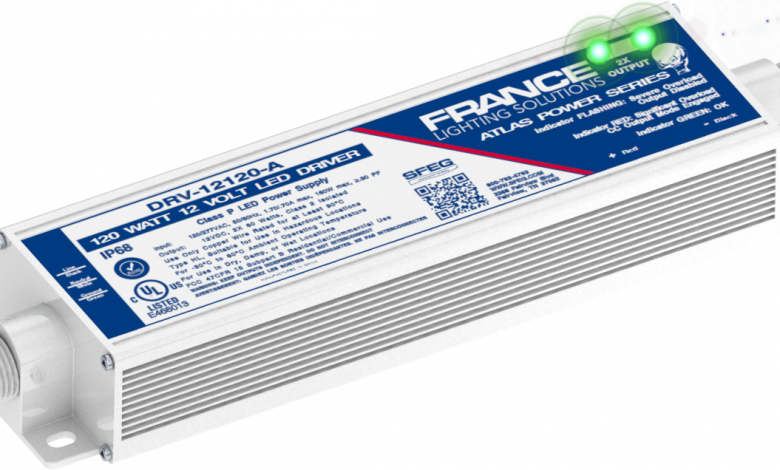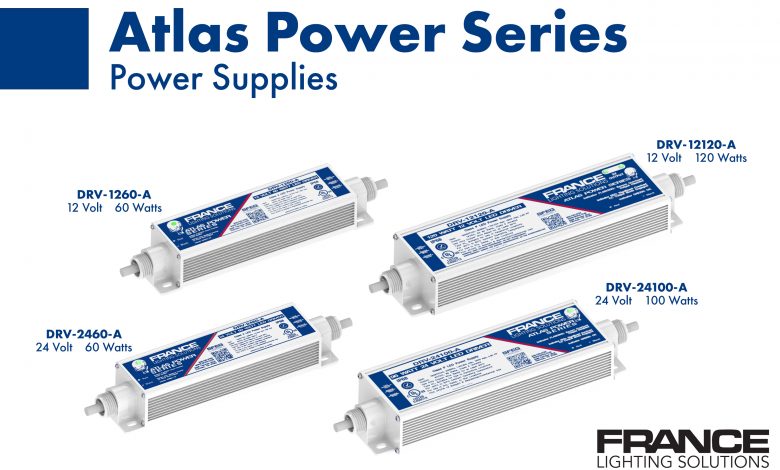Nobody likes backseat drivers. They are annoying and controlling; and they always try to manage everything to their liking. They tell you what to do, even when you are the one at the wheel. They focus on what can possibly go wrong in the present situation. Yet, in most cases we tolerate them. Their hearts are in the right place.
With LEDs, there are different types of drivers-though not so different from the backseat variety. These drivers control the amount of power that is fed to LEDs and manage the functionality of the sign. They prevent damage from what may possibly go wrong. And we are thankful for them. Power supplies (drivers) are at the heart of the LED sign.
Current Regulators
LED drivers come in a couple different formats, and they serve as a regulator of the current that enters LEDs.
“There are basically two types of power supplies for lighting,” says James Blevons, sales manager at EPtronics Inc. “Constant voltage that supplies a fixed DC voltage and will operate at a range of output current, and constant current that has a fixed maximum output current and a range of voltages allowing flexibility based on the number of LEDs are being driven.”
Because drivers are critical to extending the life of an LED and the overall sign, it’s a rare case when you wouldn’t need a driver in an LED sign project.
“Most all LED signs require a driver,” states Mike Bluhm, Director of Global Product Solutions, SloanLED. “The industry has settled into 12VDC and 24VDC as the input voltage to run the LEDs.”
Driver Selection
Now, knowing the importance of LED power supplies, how do you know which one is right for a given project? What happens when a problem occurs? How do you troubleshoot the issues? We’ll take a look at these questions and more.
Let’s first start with the elements that factor into choosing an LED driver. What must a sign maker consider when starting a project?
Voltage and Current
Voltage and current is a good place to start. “Most LED modules require either 12 VDC or 24 VDC to operate so they will need a power supply/driver to convert the incoming AC voltage to a usable DC voltage,” explains Dave Hovey, an applications engineer for Scott Fetzer Electrical Group (SFEG).
“The current required by all the LEDs in a sign,” he continues, “will dictate how many drivers will be required to illuminate the entire sign. This is normally calculated by finding out the watt rating per LED module and multiplying that by the number of modules being used in the sign.”
Oftentimes, signs will require more than one driver depending on the size and quantity of LEDs. In some situations, the current flow will vary with the desired brightness.
Blevons says that the amount of current needed is “based on the maximum brightness the customer wants from the fixture or the total current demand if the LEDs are in a parallel configuration.”
Brightness
In turn, brightness of the LEDs will impact the “the overall life they want from the LED, as the higher the current the shorter the life of the LED,” Blevons says.
With brightness, there are factors to consider outside of the driver-where the sign is located, how far away it is from viewers, indoor versus outdoor placement, and more. During most circumstances, “This is based on the circuit design of the product, and not determined by the power supply,” Bluhm says.
Temperature and Environment
According to Hovey, SFEG’s France LED driver has normal operating functionality between the range of -30°C and 60°C. “The weather and location of the LED driver will also help determine whether a driver rated for wet/dry/damp locations or one rated for dry/damp locations should be used,” he continues. “A wet listed LED driver can be used in any location.”
Externalities seem to play a role no matter the make-up of the sign. With LED signage, it can be all that more important. Whether dealing with wetness, warmth or other factors, there are elements that can impact the performance of the sign. The driver is impacted as well.
“IP (ingress protection) ratings help the user determine what power supply will work in what application,” offers Bluhm. “IP68 is the best one for water and dust protection, but they are typically more expensive due to the process of making the unit impenetrable. If a sign maker is putting the unit inside a sign or raceway, IP54 would be sufficient and lower cost.”
With extreme heat or cold, there can be varying effects.
“The driver will have longer life at lower temperatures but must also operate at very low possible temperatures in winter,” Blevons says. “Weather certainly is a factor both from a temperature and moisture point of view.”
Blevons also mentions that other weather threats, like lightning, should be considered; and driver surge protection is available.
Size
When it comes to LED drivers, size actually does matter. So, what should sign makers consider when choosing a larger or smaller power supply?
“This may be one of the most important questions to ask concerning LED installations,” suggests Hovey. “The size of the power supply will be determined by the number and power rating of the LEDs being used. A Class 2 power supply can support up to 60 watts worth of LED modules in a sign. There are also 120-watt power supplies which consist of two, 60-watt channels. For example, if an installation required 120 LED modules that are rated at .72 watts per module, the total power required would be 86.4 watts. This could be accomplished using two 60-watt class 2 power supplies (France DRV-1260-A or E) or one 120-watt power supply (DRV-12120-A or E).”
Looking at how the entirety of an LED sign is constructed may also dictate the size of your driver.
“Driver form factor is always a concern as fixtures are becoming much more ascetically pleasing as well as smaller, so drivers need to be as compact as possible while still maintaining good thermal conductivity,” adds Blevons. “Our drivers are compact and use high-quality potting and case materials to allow efficient thermal transfer to conduct heat out of the electronics to maximize life expectancy.”
Efficiency
“High efficiency drivers,” Blevons says, “generate less heat internally, requiring less heat sinking and a more flexible fixture design while still allowing a long life.”
Long life is an important aspect of an LED sign. Users have become accustomed to expecting less maintenance and extended lifespans from their LED signage.
“Most low-voltage LED power supplies work at 88 to 90 percent efficiency,” says Bluhm. “Basically, that indicates it takes 68 watts of power to generate 60 watts if the unit is 88 percent efficient on a 12VDC unit.”
Latest Features
Power supplies, in general, are an integral part of a sign. Says Blevons, “LED signs almost always need a switching power supply (optimized for driving LEDs) to convert AC voltage to DC.”
But they also bring features to the sign that can enhance the functionality. One of those is the ability to dim the lighting.
“Most LED suppliers provide dimmers that are attached to the secondary output,” says Bluhm. “These dimmers use pulse-width modulation to lower the light output of the LEDs.”
This means that signage lighting can be adjusted based on the environment or requirements of the user.
“There are generally two ways (to dim). The preferred is by lowering the output current by means of a signal to the output section of the driver generated by a 0-10V dimmer or based on a Triac or ELV wall dimmer that the driver converts to a signal reducing the current,” says Blevons. “A second way is to rapidly switch the power supply on and off based on a Triac or ELV dimmer causing the eye to perceive less light, but that method creates noise within the circuit. Our driver uses the first, also referred to as constant current reduction or CCR dimming.”
Another “feature” sign makers should be aware of is weather-proofing. With outdoor LED signs, there are always ways for moisture to slip into the display, impacting the lighting elements. Sign makers can combat this by protecting the driver or simply using one that is intended to resist the wetness.
“A sign maker can buy an IP68 power supply that has built-in features that make it weatherproof,” says Bluhm. “Otherwise they can use a UL-approved power supply box and install the units inside.”
However, Blevons warns that if some type of enclosure is used, sign makers should be cautious.
“You must keep in mind that the heat generated by the driver internally must be dissipated as I have seen poorly designed fixtures that do not provide a means of removing this heat and will greatly reduce the life of the driver,” he says.
Overcoming Failure
Finally, we can talk about what to do in case of emergency. How do you overcome obstacles? What should you do to improve the performance of your driver and LED sign? When do you know it’s time to make replacements?
There are a number of precautions to take including, “Testing the primary and secondary wires with a volt meter for output is the most common method for trouble shooting power supplies,” offers Bluhm.
In a similar fashion, Hovey points to the input voltage indicator that is present on The France Atlas Power Series. “It will be green when everything is working and red if it is overloaded,” he says. “If it is flashing, there is a serious problem in the LED string. With the power turned off, disconnect the LEDs from the power supply. Turn the power back on and check the indicator again. If it is green, there is a problem with the LED string. If it is still flashing or red, then the power supply has an internal problem.”
When using products that have no indicators, sign makers can still evaluate the configuration for problems.
“If there is no indicator, find the last LED module in the string and measure the DC voltage after that module,” instructs Hovey. “It should be above 10 VDC. If it is lower, turn the power off and disconnect the LEDs from the power supply. Turn the power back on and measure the output of the power supply. If it is 12 VDC there is a problem with the LED module string. If it is less than 10 VDC at the power supply, then it should be changed.”
At some point, users will recognize when it is time to replace the driver-in the case of failure or an unforeseen problem. But in many instances, the LEDs may give out first.
“If routine maintenance is planned, drivers are sometimes replaced if they are near the end of their expected life,” says Blevons, “otherwise if a fixture is not operating properly it just needs to be determined if the issue is due to failure of the LEDs or the driver, which is usually done by installing a new driver temporarily and confirming correct operation right away.”
Unexpected Failures
There may also be instances when users simply do not know what problems are occurring. Blevons says that, “if you are having unexpected failures you will want to monitor the case temperature in the application and the input voltage to ensure they are within the expected ranges as those are the two most common failure modes.”
However, if the correct drivers are chosen-those that can withstand the elements and handle the LED output-most problems can be sidestepped. When drivers are functioning properly, they are running LED signs efficiently and effectively. And these are drivers that get the most mileage out of each sign.




